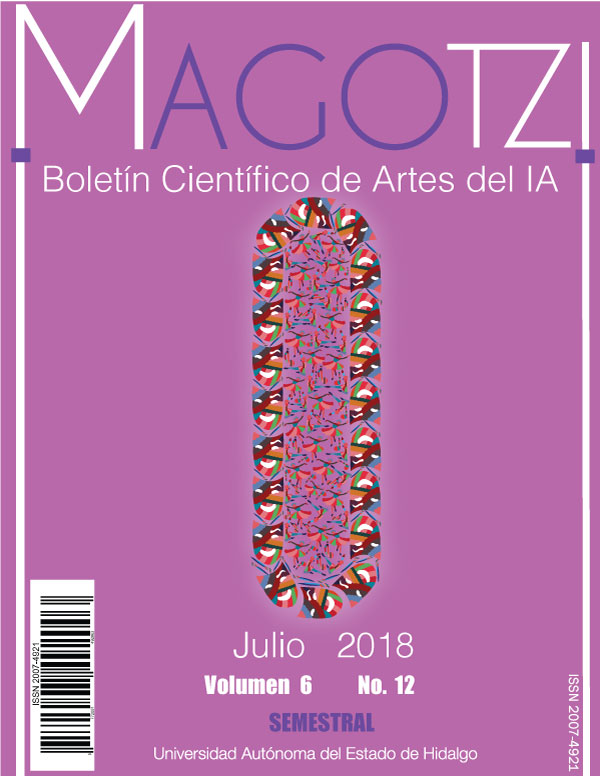Exploratory study on the independent rock scene in Nayarit
Abstract
Nayarit, founded only in the second decade of the last century, does not seem to have been left out of the process of emergence of rock in Mexico, however, specify the exact moment when rock music is introduced in this state is a task of extreme complexity , an immediate reference to which we can turn initially corresponds to a generalized perspective, with the emergence of "rock and roll" groups in Mexico approximately between 1955 and 1970, under the influence of American musical groups of the time. The present article corresponds to a research that explores the rock scene of Nayarit, which seems to have had a peculiar historical development and evolution that has allowed it to keep up to date, simultaneously with typical musical forms that they conform the musical identity of Nayarit. For this purpose, some theoretical references were analyzed as inputs for the analysis of the characteristics of the rock phenomenon in this state, integrating some anecdotes and opinions of musicians belonging to active and disappeared rock bands in Nayarit.
Downloads
References
Analco, A. y Zetina, H. (2000). Del negro al blanco breve historia del ska en México. México: Instituto Mexicano de la Juventud.
Bourdieu, P., J. Chamboredon y J.. Passeron (2002). El oficio del Sociólogo Presupuestos Epistemológicos. Argentina: Siglo XXI Editores.
Byrne, D. y Hilly, K. (200). CBGB & OMFUG: Thirty Years From The Home Of Underground Rock. Estados Unidos: Harry N. Abrams, Inc.
Carranza, J.J. (2007). El son de la negra: orgullosamente de Tepic: la historia detrás de la musa. México: XXXVII Ayuntamiento de Tepic.
Chastagner, C. (2012). De la cultura Rock. Argentina: Paidós.
Dennison, L. y Shaw, S. (2005). Pop Culture Latin America!: Media, Arts, and Lifestyle. Estados Unidos: ABC CLIO.
Escobedo, F. (2009). Compositores de Nayarit. México: Asociación de Autores y Compositores de Nayarit.
Frith, S., Straw, W. y Street, J. (2006). La otra historia del rock: aspectos clave del desarrollo de la música. España: Ediciones Robinbook.
Galván, H. (2013). Rock impop: El rock mexicano en la radio Top 40. Recuperado desde: Acceso link aquí
Gillett, C. (2008). Historia Del Rock: El Sonido de la ciudad. España: Ediciones Robin Book.
Green, L. (2002). How Popular Musicians Learn: away ahead for music education. Aldershot: Ashgate Publishing
Green, L. (2008). Music, Informal Learning and the School: A New Classroom Pedagogy. Inglaterra: Ashgate.
Guber, R. (2004). El salvaje metropolitano reconstrucción del conocimiento social en el trabajo de campo. Argentina: Paidós.
INEGI (2015). Número de habitantes. Recuperado desde: Acceso link aquí
Jáuregui, J. (2010). El son mariachero de la La negra: de gusto regional independentista a aire nacional contemporáneo. Revista de Literaturas Populares, 10(2), 270-318
Jáuregui, J. (2012). El mariachi símbolo musical de México. Música oral del sur: música hispana y ritual, (2), 220-240. Recuperado de: Acceso link aquí
Kozinn, A. (1995). The Beatles. Londres: Phaidon Press.
Lange, L. (2007). The Beatles Way: Fab Wisdom for Everyday Life. Nueva York: Atria books/Beyond Words
Latour, B. (2002). La esperanza de pandora ensayos sobre la realidad de los estudios de la ciencia. España: Gedisa.
Leyshon, A., Webb, P., Shaun, F., Thrift, N. y Crewe, L. (2005). On the Reproduction of the Music Industry After the Internet. Media, Culture, and Society, 27 (2), 177-209.
Liffman, P. M. (2011). Huichol Territory and the Mexican Nation: Indigenous Ritual, Land Conflict, and Sovereignty Claims. Estados Unidos: The University of Arizona Press.
Negut, A. y Sârbescu, P. (2014). Problem music or problem stereotypes? The dynamics of stereotype activation in rock and hip-hop music. MusicaeScientiae, 8(1), 3-16.
O’Connor, A. (2004). Punk and globalization Spain and Mexico. International Journal of Cultural Studies, 7(2), 175-195.
Quintero, A.G. (1998). Salsa, sabor y control!: sociología de la música "tropical". México: Siglo XXI Editores.
Ragland, C. (2009). Música Norteña: Mexican Americans Creating a Nation Between Nations. Estados Unidos: Temple University Press.
Santos, S., Carillo, T. y Verdín, K.I. (2016). The revitalization of Wixárika: A community project in the midwest region of Mexico. En Pérez, G., Rogers, C. y Rosés, J. (Eds.), Language Documentation and Revitalization in Latin American Contexts (pp. 81- 108). Alemania: De Gruyter Mouton.
Shuker, R. (2009). Rock total: Todo lo que hay que saber. España: Robinbook.
Shuker, R. (2005). Popular Music: The Key Concepts. Gran Bretaña: Routledge.
Simonett, H. (2004). En Sinaloa Nací: historia de la música de banda. Mazatlán: Asociación de Gestores del Patrimonio Histórico y Cultural de Mazatlán, A.C.
Strauss, A., y Corbin, J. (1998). Basics of Qualitative Research. Techniques and Procedures for Developing Grounded Theory. USA: Sage.
Torres, V. (2002). Rock-Eros en concreto: génesis e historia del rockmex. México: Instituto Nacional de Antropología e Historia.
Valenzuela, R. (2004). Rock tapatío: la historia por contar. Guadalajara: Centro Universitario de Ciencias Sociales y Humanidades
Wicke, P. (1990). Rock Music: Culture, Aesthetics and Sociology. Australia: Cambridge University Press.











